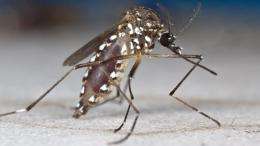An eye for the tsetse fly

(PhysOrg.com) -- Geoffrey M. Attardo was one of those little boys who made pets of the spiders outside his bedroom window, feeding them and watching as they spun intricate webs. Age has not diminished his fascination with the insect/arthropod world.
Attardo now studies tsetse flies for a living and photographs them as a hobby. His growing collection of insect photographs has resulted in a book and, more recently, an award.
An associate research scientist in the division of Epidemiology of Microbial Diseases, Attardo, researches the reproductive biology of insect vectors of human disease. His doctoral thesis in genetics at Michigan State University focused on how the nutritional components of blood regulate yolk protein gene expression in the yellow fever mosquito.
Prior to embarking on his graduate studies, Attardo seriously considered a career in graphic design, illustration and photography, but science ultimately won out. At that time he was head technician for a medical entomology lab at the University of Massachusetts, Amherst, where he was the first and last undergraduate to begin a major in entomology as a freshman.
His current work in the lab of Serap Aksoy, professor in the division of Epidemiology of Microbial Diseases, involves the molecular characterization of reproductive processes of the tsetse fly (Glossina morsitans morsitans), a viviparous insect that transmits sleeping sickness in regions of sub-Saharan Africa. His work examines many aspects of tsetse reproduction, including nutrient metabolism and mobilization to intrauterine offspring; identification and characterization of reproductive genes and regulatory mechanisms; and the role of the symbiotic bacteria (Wigglesworthia) in tsetse fertility. Tsetse flies are one of the only types of insect that lactate and provide nutrients for their young during the entirety of their development.
While photography and illustration are sidelines for Attardo, they enhance his publications, his lab’s and YSPH’s websites and his insight as a scientist. One of his photos, a tsetse close-up, was recently selected as an Image of the Year by the National Institutes of Health John E. Fogarty International Center.
“It’s good to look at the whole picture of an organism you are working with,” explains Attardo. “Photos tell me about the insect’s history and lifestyle and the story of its adaptations. When doing molecular biology it’s easy to lose sight of the forest for the trees.” Details in pictures such as coloring, surface textures, and anatomy that are brought out through macro photography allow him to make connections that many molecular biologists might lose sight of. “The more I study biology, the more I see how all life is connected and how it makes amazing adaptations to survive in difficult places. All living things are just trying to make their way in the world. Even creatures many consider to be gross or creepy are fascinating when you take a close look at them.”
When photographing tsetse in the laboratory, Attardo temporarily incapacitates the specimen by using carbon dioxide or ice. Without harming the creature, these substances slow the subject’s movement and eliminate the risk of escape. They also allow Attardo to focus on the incredible and often beautiful details that go unnoticed to the casual observer.
Digital cameras have played a big part in this hobby, he explains, since, unlike shooting with traditional film, the feedback on shutter speed and aperture settings is immediate. Macro photography is a delicate art of balance — between lighting at close range, exposure and the blur of a moving creature. Attardo generally uses a Canon EOS Rebel T2i SLR with a macro lens and ring flash to capture his quarry. He has also used a scanning electron microscope to attain a level of detail that is not possible with a hand-held camera.
Attardo has published a book of insect images, Small World: Life is in the Details, and his hobby has taken him well beyond the lab to photograph an array of other subjects, including tarantulas, slugs, butterflies, scorpions and crickets.
Shooting in the wild, says Attardo, requires patience, a good eye, a steady hand and luck. Generally insects will let you get close enough to take a good look at them if you use slow movements and try to make yourself a part of the environment. If you are quiet enough, sometimes they don’t even realize you are there. At times, Attardo says, his subjects have crawled right onto his lens.
To see more of Attardo’s photos, visit his website.
Provided by Yale University


















